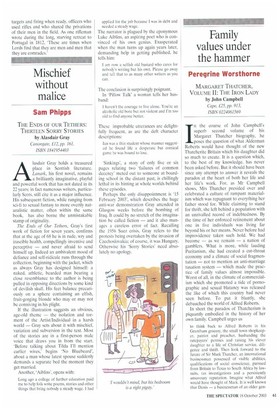A regiment to reckon with
Ian Garrick Mason
RIFLES: SIX YEARS WITH WELLINGTON'S LEGENDARY SHARPSHOOTERS by Mark Urban Faber, £20, pp. 351, ISBN 0571216803 1 nthe spring of 1990, at the age of 21, I found myself sitting on an English hillside in the sun as one member of a brand-new training platoon of British squaddies. Having been marched up hill and down dale for a couple of hours that afternoon, we were handed large cans of beer by the corporals and told to stand up one by one — in front of the platoon, its NC0s, and its lieutenant — to explain what motivated us to join the Light Division. As a university-educated
Canadian, my own reasons were oddsounding and faintly naive, while the other soldiers' reasons had an enviable clarity: 'I got a job as a builder, but my supervisor was a twat. So I hit him in the head with my shovel.' I worked in mines, and during last strike, union paid me hundred pounds to lock management in pit. I did, but I got fired.' I bet my mate fifty quid that I would join the Army — and I won, didn't I? I hate it already.'
In the Duke of Wellington's day, the 95th Rifle Regiment at least paid new recruits a bounty of ten guineas, even if most drank that bounty away as quickly as they could gulp. But there were other enticements: 'NO WHITE BELTS! NO PIPE CLAY! ... your Quarters are the best in the Army ... you have the first of every thing,' promised a regimental recruiting poster which is reproduced on the frontispiece of Mark Urban's remarkable new history, Rifles: Six Years with Wellington's Legendary Sharpshooters. His book tells the story of the Light Division's 95th Rifle Regiment through its service in the Peninsular War from 1809 to 1814, and in the renewed fighting that led to Waterloo.
From the start, the Rifles were different. They wore green jackets, not red coats; they used natural cover for concealment and defence, and they moved and fought in skirmish lines and loose order, rather than standing shoulder to shoulder as the traditional line regiments did. Their Baker rifles were accurate at much greater ranges than muskets were, which in turn allowed the riflemen ruthlessly to target French officers during battle, and to compensate in killing power for the slower reloading speed of the rifle.
To the conservative military establishment at Horse Guards, the Rifles were at first no more than 'a very amusing plaything'. Rapidly, though, they proved their mettle in both skirmish and full-scale battle with French regulars in the rugged hills of Portugal and Spain. Urban describes these engagements in a factbased style that still somehow manages to raise the reader's heart rate. His chapter on the battle at the Coa river is as harrowing and graphic as the D-Day scene in Saving Private Ryan: 'Balls were whistling about the ears of the riflemen, ricocheting dementedly off rocks, whining into the air. Every now and then there'd be the slap of a bullet hitting flesh and the cry of another man going down.' Outnumbered, the regiment staged a desperate, fighting retreat. The French soldiers came on 'like swarms of bees,' wrote one British rifleman, and 'hunted us down the mountains like deer.'
Rifles is no regimental history of the old school, for Urban doesn't flinch from portraying the dark side of war and of soldiers brutalised by too much of it. He details the petty thieving from local villages, the floggings for indiscipline and drunkenness, even the atrocities: after the astonishingly brave and bloody storming of the citadel of Badajoz, riflemen and light infantry joined in the sacking of the town, the rape of Spanish women and girls, and the murder of those men who tried to defend their families and property. Wellington was forced to start hanging soldiers to stop the orgy of violence.
Yet Urban finds the humanity, too. After a young French prisoner nearly shot Lt. Col. Beckwith's head off, holing his hat instead, the officer spared him: 'Let him alone; I daresay the boy has a mother.' In winter quarters, the troops whiled away the hours by reading novels like Don Quixote and putting on skits. On picket duty, they fraternised with their French opposite numbers.
By the end of the Peninsular War, the Rifle Regiment had proved itself one of the best in the British Army. More importantly, it influenced the future development of that army: the new drill manual of 1824, for example, put more emphasis on skirmish tactics than on linear warfare. It is disappointing that Urban does not offer a postscript in which to reflect on the role of the regiment's descendants, the Royal Green Jackets and the Light Infantry, each of which has a battalion now assisting in the occupation of Iraq. But he concludes on the right note, highlighting the Rifles' advanced views on soldiers and officers — soldiers who were trusted for the first time with the responsibility of choosing their targets and firing when ready, officers who used rifles and who shared the privations of their men in the field. As one rifleman wrote during the long, starving retreat to Portugal in 1812, 'These are times when Lords find that they are men and men that they are comrades.'



































































































 Previous page
Previous page